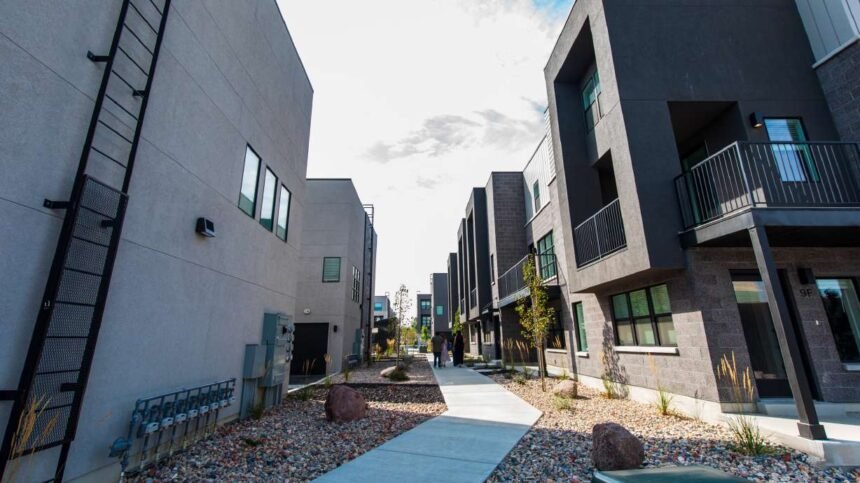SALT LAKE CITY — Long before visions of baseball and large buildings at the soon-to-be redeveloped Rocky Mountain Power headquarters, Cole West developers saw an opportunity.
This was about six years ago, and Salt Lake City was in the middle of planning for the future of the Jordan River. The city had also just completed the Archie and Lois Archuleta Bridge, creating seamless travel along the Jordan River Parkway Trail over the railroad tracks between 200 South and North Temple.
The Centerville-based homebuilder toured the area and found what it believed to be an “overlooked” site for housing. That decision led to the creation of TheYard, an 8.5-acre rental townhome community that is now open.
Developers and others associated with the project gathered with city officials on Thursday to celebrate the partial opening of the complex, which will feature 157 multiunit townhomes when it’s completed. It may just be the unofficial start of the forthcoming “Power District.”
“This is kicking off the Power District, folks,” said Peter Makowski, deputy director of development for Salt Lake City. “I think we’re all really excited about what’s coming to this part of our city, and it’s amazing to see it already happening.”
Building a new community
The complex, located at 125 S. Navajo Street, was home to the Mark Steel Company in a once-industrial part of Poplar Grove. Project developers believed there was a lot to like about the large site, even though it was dingy, said Walker Wood, vice president of development for Cole West.
There was plenty of space to work with in an area that’s a short drive from I-80 and downtown and not terribly far from a light-rail station. Salt Lake City was also putting in work to enhance the Jordan River — and the trail running alongside it — that’s next to the site, adding to its appeal. All of these fit into the company’s interests in urban development and master-planned communities.
“We felt like it’s rare to have that opportunity, and one we wanted to capitalize on,” Wood told KSL.com, explaining that the company considered several options for the space. “We landed on a townhome concept because we felt like that was the best blend of new community and … redevelopment of some of this area to tie into the existing infrastructure.”
It also helped that the area qualified as an opportunity zone, which provides tax incentives to developers like Cole West who flip “distressed areas” into projects that promote economic growth and job creation. That’s something the company received, which aided in getting the project off the ground.
Still, it took years to go from concept to construction because the project required extensive land remediation. Construction only began two years ago, once the remediation wrapped up and funding was secured.
“To know the entire journey that happened with this project — it’s truly a miracle. It’s a combination of a ton of mini miracles,” said Darlene Carter, CEO of Cole West.

About half of the planned 157 units are now open and available for rent. The rest are on track to open over the next few months, according to Wood.
Nearly 100 of the units will feature three or four bedrooms, adding space for families or young adults splitting rent with roommates. Rents range from $2,395 to $3,095 per month.
“This community is really about welcoming in a type of renter that is looking for proximity downtown, but often doesn’t have the open space and unit size that is undersupplied in our fast-growing city,” he said.
More to come
Additional work includes collaborating with Salt Lake City and Union Pacific to handle regulations on horns from trains running along tracks directly north of the site.
While Salt Lake City’s two “quiet zones” were reestablished after compliance issues were resolved, they don’t include multiple crossings west of the Jordan River. That means westbound operators will likely blow train horns next to the complex until nearby crossings are recognized within a quiet zone.
“This is one of the high-priority zones that we think will become quiet in the future,” Wood said, moments before a locomotive passed by.
For now, TheYard is leaning into the rails and the location’s industrial past in marketing, he said. A picture of a Grand Canyon lookout, made from steel fabricated at the old factory, is displayed in a community space on the property, along with other steel-themed photos.

The development’s future could also mean becoming part of a much larger community. Salt Lake City leaders signed off on a rezone of 93 acres late last year that the Larry H. Miller Company acquired from Rocky Mountain Power. The company’s plans could include a Major League Baseball stadium, should Utah land a franchise, as well as mixed-use development with taller heights on the other end of the tracks.
Utah leaders are interested in finding more year-round uses of the Utah State Fairpark, located northwest of TheYard, while Salt Lake City is eying new uses for the Fisher Mansion across the river. That means the area surrounding TheYard may look completely different in the next decade.
“I truly believe that the residents here are going to be at the forefront of some amazing possibilities for what the Power District is going to be,” Carter said.
The Key Takeaways for this article were generated with the assistance of large language models and reviewed by our editorial team. The article, itself, is solely human-written.











